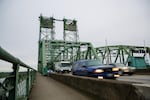For drivers hoping a new Interstate 5 bridge between Portland and Vancouver would put an end to bridge lifts and ensuing traffic snarls, well, you might want to sit down.
Planners in charge of the new, multibillion-dollar overhaul have recently been told by federal regulators they must include plans for “moveable span” on the bridge. Greg Johnson, who is leading the team of planners, said federal regulators made the order in late February.

The Interstate 5 bridge connecting Washington and Oregon across the Columbia River as seen from Vancouver, Washington, Saturday, Dec. 15, 2018. Federal regulators recently told planners of a bridge replacement that they may need to include a bridge lift in their plans.
Bradley W. Parks / OPB
The reason? The bridge as currently planned may be too short, Johnson said. The 116-foot-tall bridge needs to be blueprinted at least 62 feet taller if it were to accommodate ships on the Columbia River without a lift.
“This is a change, but once again it’s a change that we’re going to make sure we’re getting done now so we don’t have delays at a future time,” Johnson said in an interview Friday.
Planning for a lift doesn’t mean the bridge will have one, however. A final design decision has not been made. The planning administrator said they hope to strike a deal with companies so they wouldn’t need a 178-foot-tall clearance.
“We are in negotiations with impacted users to eliminate any need for anything over 116 feet,” he said.
Johnson stressed multiple times that the study of a bridge lift option should not impact timing. His team, which is jointly funded by Oregon and Washington, is still aiming to start building the new bridge in 2025. But that means hitting multiple planning milestones between now and then.
The next milestone is releasing a document called the “draft supplemental environmental impact statement.” The Federal Transit Administration and the Federal Highway Administration, in consultation with the U.S. Coast Guard, want to see plans for the moveable span as part of that document.
According to Johnson, the team already has two contracted firms that can start working on designing plans for a moveable span.
Johnson could not say specifically how much the new plans would cost. He said they would “probably” cap the costs at $200,000.
“We are doing our due diligence to stay on our schedule. And schedule is a driver of cost,” Johnson said. “We’re trying to be ultra-responsive so we don’t miss key schedule dates.”
In December, Johnson revealed that the project’s price tag had risen. Previous estimates in 2020 ranged between $3.2 and $4.8 billion. Now, the cost is between $5 and $7.5 billion.
Transportation officials blamed multiple economic issues: inflation, supply chain problems and workforce shortages. Infrastructure projects across the United States faced the same crunch, Johnson told OPB at the time.
A “moveable span” could come in a few different forms, but only two are really viable for this project, Johnson said.
One is a vertical lift, such as the current I-5 bridge, which hoists a section of the bridge up into the air. This method still puts an upper limit on the height of ships able to use the waterway.
Johnson said he preferred a “bascule” method — as seen on the Burnside and Broadway bridges in Portland — which tilts the section vertical to create an opening. This method puts no ceiling on ship height.
Making the bridge taller to avoid requiring a lift isn’t an easy solution. The bridge needs to allow on- and off-ramps that aren’t too steep, and needs to connect to Hayden Island and Washington’s State Route 14. Any higher would also prevent light rail, Johnson added.
“There are numerous reasons why 116 feet is the sweet spot for us,” he said.
The bridge’s height poses a particularly interesting spatial question on the Washington side. Planners must thread it between millions of dollars of new construction, a national park and a railroad.
The city of Vancouver has in recent years seen investment pouring into its waterfront. New construction — some already built, some still in planning — bookends the current I-5 bridge. Fort Vancouver National Park also comes near the eastern edge of the bridge and the freeway.
The bridge would also have to rise over a railroad structure. Currently, drivers pass under that railroad structure before entering or exiting the I-5 bridge on the north end.
The bridge does this currently at its 116-foot plans, Johnson said. As designed, it would touch into Vancouver around Evergreen Boulevard, near the Vancouver Community Library.